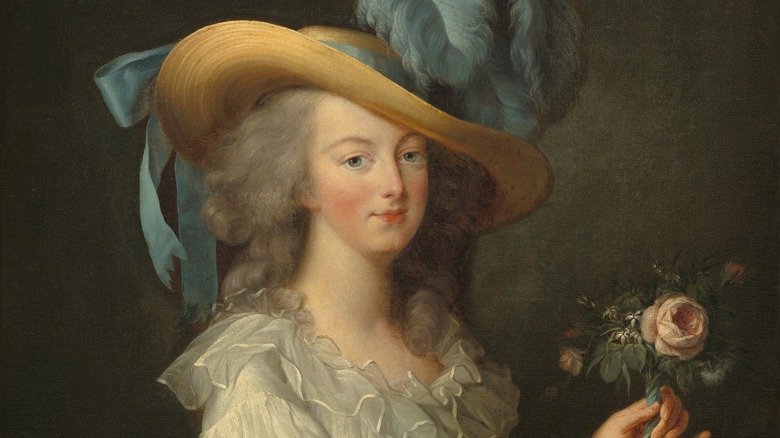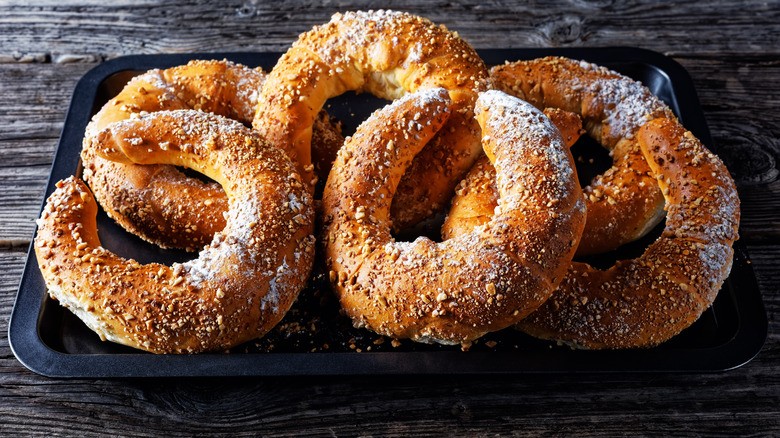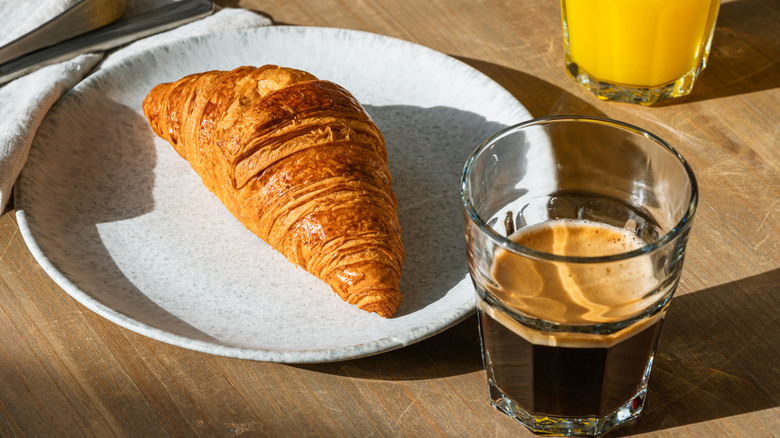Marie Antoinette Didn't Bring The Croissant To France. So Who Did?
Marie Antoinette, the last Queen of France, is the stuff of myth. Her name alone evokes images of delicate pastries in pastel hues, whipped cream and, of course, towering cakes. Most people know her by the falsely attributed "let them eat cake" quote, which was used to spur the French Revolution. But this is hardly the end of the Austrian-born Queen's food-based lore.
Some history buffs will also note that Marie Antoinette also had a habit of eating fruit out of season, thanks to Versailles' ample kitchen gardens. But have you heard the story that Marie Antonette is responsible for introducing the croissant to France? According to legend, the royal brought the crescent-shaped Kipfel to France in order to ease her homesickness for Austria in the 1700s, spawning a trend for the crescent prototype across France.
While this anecdote, like that old cake quote, is ripe for a good story, it simply isn't true. Though the modern-day croissant is, like Marie Antoinette, Austrian in origin, it actually didn't make its way over to France until well after Mare Antoinette exited the stage of history. Rather, we have an Austrian baker, August Zang, to thank. Zang introduced the Austrian delight to France in 1839 when he opened a bakery that served kipfel in Paris. However, it would be a long and winding road until they took their final buttery, flaky form.
How crescents took shape
There are several competing narratives behind the origins of the croissant, but what's certain is that the baked good did originate in Austria. Some attribute the origins of the croissant to 1683, when Viennese forces managed to halt an Ottoman invasion in the Austrian city. Legend has it that bakers in Vienna were to thank for this victory, as they were the ones to catch Ottoman forces tunneling their way into the city. The crescent-shaped kipfel was created as a response to this victory, shaped like the crescent moon, which was the symbol of the Turkish flag. So, essentially, eating a kipfel was akin to 'eating' their opponent (metaphorically speaking). The kipfel was therefore a symbol of victory, and disrespect for the would-be conquerors. This is a great story, of course, but it simply isn't true.
The real origins of the kipfel (and therefore the croissant) date all the way back to the 13th century. During this time, the rolls were baked in monasteries, and were often eaten during celebrations of religious holidays such as Easter. Over the centuries, however, kipfel (or kipferl) became a standard baked good at many Viennese bakeries. And though Marie Antoinette may very well have eaten kipfel during her early Austrian years, there's no proof that she brought the product over to France. Even if she had, it would hardly resemble the modern-day croissant. That wouldn't take shape until the 20th century.
The bridge between kipfel and croissant
Though the Austrian kipfel is the progenitor of the now iconically French croissant, the two pastries are actually quite different. When Austrian baker August Zang introduced the kipfel to Paris in 1839, the treat looked nothing like its current form. Zang's kipfel weren't flaky or buttery, but had a brioche bread-like base that was both fluffy and soft, similar to a roll or milk bread. And the name? Well, French customers soon turned kipfel into croissant, in owing to its crescent shape.
It wouldn't be until 1915 that the flaky croissant that we all know and love was formally introduced. This was when Sylvain Claudius Goy recorded a new variation on the recipe, which used a butter-laminated yeast-based recipe to create the modern version of the croissant. This recipe called for cold butter and yeast dough to be folded into layers, creating a risen, flaky texture essential to so many French pastries. It didn't take long for this flaky pastry to become integral to French culture and cuisine, as it was officially recognized as a national product in 1920. You can now find croissants in any French patisserie worth its flour. And regardless of the pastry's origins, there's no doubt that the croissant, much like Marie Antoinette, is a quintessentially French icon.


